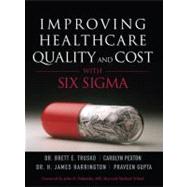
| Foreword | p. xx |
| Introduction | p. xxi |
| The Need for Cutting Costs and Improving Quality in Healthcare | p. 1 |
| Trends in the Healthcare Industry | p. 3 |
| Excellence (Benchmarks) and Improvement Challenges in the Healthcare System | p. 21 |
| Applicability of Six Sigma in Healthcare Organizations | p. 31 |
| Methodology, Tools, and Measurements | p. 59 |
| The Healthcare Opportunity | p. 61 |
| Six Sigma Methodology | p. 77 |
| Understanding Problems: Define, Measure, and Analyze | p. 89 |
| Solving Problems: Improve and Control | p. 129 |
| Benefiting from Six Sigma | p. 161 |
| Case Study Introduction and Profiles | p. 163 |
| Clinical Case Studies | p. 181 |
| Operational Case Studies | p. 203 |
| Rolling Out and Sustaining Six Sigma | p. 239 |
| Implementing a Six Sigma Culture | p. 241 |
| Lean Six Sigma in Healthcare | p. 373 |
| The Road Ahead | p. 401 |
| Appendixes | p. 431 |
| PMBOK Tools and Techniques | p. 433 |
| The Six Sigma Body of Knowledge | p. 437 |
| Total Six Sigma Tools Self-Evaluation Form | p. 445 |
| Additional Resources | p. 451 |
| The Man I Want To Be! | p. 453 |
| Index | p. 455 |
| Table of Contents provided by Publisher. All Rights Reserved. |
The New copy of this book will include any supplemental materials advertised. Please check the title of the book to determine if it should include any access cards, study guides, lab manuals, CDs, etc.
The Used, Rental and eBook copies of this book are not guaranteed to include any supplemental materials. Typically, only the book itself is included. This is true even if the title states it includes any access cards, study guides, lab manuals, CDs, etc.